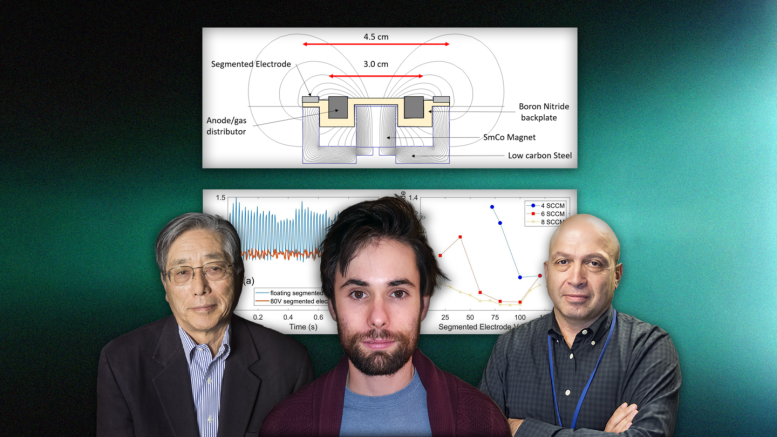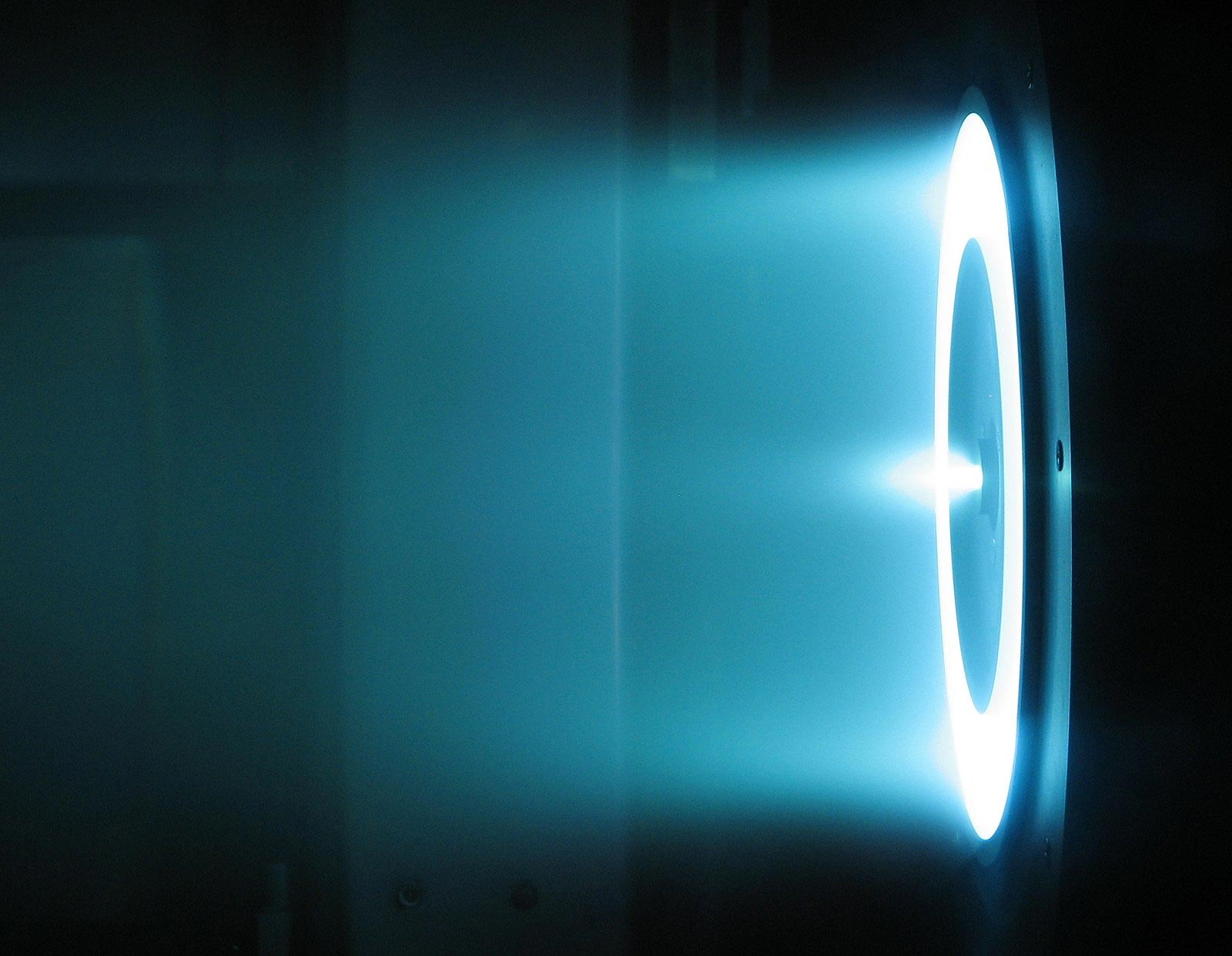A solar-powered Hall-effect thruster tested under vacuum conditions at NASA. Credit: NASA
The plasma-based rocket designed for deep space exploration lasts longer and generates high power.
The increased interest in deep space travel has necessitated the development of powerful and durable rocket systems to propel spacecraft into the cosmos. Scientists at the U.S. Department of Energy’s (DOE) Princeton Plasma Physics Laboratory (PPPL) created a small modified version of a plasmapropulsion system based on a propulsion system known as a Hall thruster that both improves rocket life and produces high power.
The miniature plasma-powered device measures less than an inch in diameter and removes the walls surrounding the plasma thruster to create innovative thruster configurations. Plasma is a state of matter composed of floating electrons and atomic nuclei, or ions. Among these innovations are the cylindrical Hall thruster, which was originally designed and studied at PPPL, and a completely wallless Hall thruster. Both configurations reduce channel erosion generated by plasma-wall interactions, which limits thruster lifetime – a major problem for typical annular or annular Hall thrusters and especially for low-power miniaturized thrusters used on small satellites.
Widely studied
Cylindrical Hall thrusters were invented by PPPL physicists Yevgeny Raitses and Nat Fisch in 1999 and have been studied with students in the Laboratory’s Hall Thruster Experiment (HTX) ever since. PPPL devices have also been studied in countries such as Korea, Japan, China, Singapore, and the European Union, with Korea and Singapore considering flying them.
While wallless Hall thrusters can minimize channel erosion, they face the problem of severe plasma thrust plume broadening or divergence, which degrades system performance. To reduce this problem, PPPL installed a key innovation on its new wallless system in the form of a segmented electrode, a concentrically joined current carrier. This innovation not only reduces divergence and helps intensify rocket thrust, Raitses said, but also removes hiccups from small Hall thruster plasmas that interrupt smooth power delivery.

Graduate student Jacob Simmonds, center, with advisors Masaaki Yamada, left, and Yevgeny Raitses with the Wallless Hall thruster figure behind them. Credit: Photos of Yamada and Raitses by Elle Starkman/Communications Office; Photo of Simmonds by Tyler Boothe. Collage by Kiran Sudarsanan.
The new findings cap a series of papers that Jacob Simmonds, a graduate student from princeton university Department of Mechanical and Aerospace Engineering, published with Raitses, its PhD co-supervisor; PPPL physicist Masaaki Yamada is the other co-advisor. “Over the past two years, we’ve published three papers on new plasma thruster physics that led to the dynamic thruster described in this one,” said Raitses, who leads PPPL low-frequency plasma physics research. temperature and the HTX. “It describes a new effect that promises new developments in this area.”
The application of segmented electrodes to Hall thrusters is not new. Raitses and Fisch had previously used such electrodes to control plasma flow in conventional annular Hall thrusters. But the effect that Simmonds measured and described in the recent article by Applied Physics Letters is much stronger and has a greater impact on the operation and overall performance of the thruster.
Plume concentration
The new device helps overcome the problem of wallless Hall thrusters that allow the plasma thruster to fire from the rocket at wide angles, contributing little to the rocket’s thrust. “In short, wallless Hall thrusters, while promising, have a hazy plume due to the lack of channel walls,” Simmonds said. “So we needed to find a way to focus the plume to increase thrust and efficiency and make it a better overall propellant for spacecraft.”
The segmented electrode diverts some of the electrical current from the thruster’s high voltage standard electrode to shape the plasma and shrink and improve plume focus. The electrode creates this effect by changing the directions of the forces inside the plasma, particularly those on the ionized xenon plasma that the system accelerates to propel the rocket. Ionization transformed the xenon gas used in the process into self-contained electrons and atomic nuclei, or ions.
These developments increased thrust density by shaping more of it into a reduced volume, a key goal for Hall thrusters. An added benefit of the segmented electrode was the reduction of plasma instabilities called breath-mode oscillations, “where the amount of plasma increases and decreases periodically as the rate of ionization changes over time,” Simmonds said. Surprisingly, he added, the segmented electrode made these oscillations disappear. “Segmented electrodes are very useful for Hall thrusters for these reasons,” he said.
The new high-thrust-density rocket can be especially beneficial for tiny cubic satellites, or CubeSats. Masaaki Yamada, co-doctoral adviser to Simmonds who directs the Magnetic Reconnection Experiment (MRX) which studies the process behind solar flares, the aurora borealis and other space phenomena, proposed the use of a system of segmented electrodes without walls to power a CubeSat. Simmonds and his team of undergraduates working under Professor Daniel Marlow, Evans Crawford 1911 Professor of Physics at Princeton, took up this proposal to develop a CubeSat and such a rocket – a project that was halted nearly complete by the COVID-19[feminine] pandemic and which could resume in the future.
Reference: “Mitigation of Breathing Oscillations and Focusing of the Plume in a segmented electrode wall-less Hall thruster” by J. Simmonds and Y. Raitses, November 22, 2021, Applied Physics Letters.
DOI: 10.1063/5.0070307
Support for this work comes from the DOE Office of Science.
PPPL, at Princeton University’s Forrestal Campus in Plainsboro, NJ, is dedicated to creating new knowledge about the physics of plasmas – ultra-hot, charged gases – and developing practical solutions for creating energy of merger.

